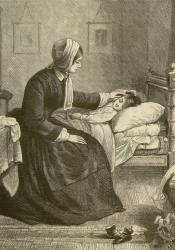Typhus Fever Outbreak
Typhus fever is a group of diseases caused by bacteria spread to humans by fleas, lice, and chiggers. Common symptoms of Typhus are high fever, headaches, chills, and muscle aches. The disease is spread by body lice from human to human (Typhus Fevers). It comes as no surprise that in the novel Jane Eyre, by Charlotte Brontë, the schoolgirls staying at Lowood were getting sick with Typhus. Bronte writes, “that forest-dell, where Lowood lay was the cradle of fog and fog-bred pestilence, which, quickening with the quickening spring, crept into Orphan Asylum, breathed typhus through its crowded school-room and dormitory, and, ere May arrived, transformed the seminary into a hospital” (Bell). The outbreak occurred nationwide in 1837-38 century, killing sixteen thousand humans every year for five years (Douglas).
It is argued through research of the novel that Brontë portrays the girls a Lowood as victims of institution neglect rather than as the victims of their own habits. Researcher Fran Thielman writes, “Jane Eyre was written during an historical moment in which public health regulation was greatly needed. Influenza, smallpox, cholera, tuberculosis, typhoid, typhus, scarlet fever, and diphtheria were the main diseases responsible for the public health crisis in
Britain, particularly before 1850” (Thielman 1).
On the other side of the argument researchers state that Brontë inaccurately named the disease, confusing it with Typhoid fever. Both diseases have the same symptoms, but they are contracted in a different way. Researcher Sylvia Pamboukian writes, “Victorians used to confuse Typhus, which is spread through body lice with Typhoid which is spread by eating food or drinking water contaminated with the Salmonella typhi, which are bacteria related to the Salmonella you might have heard causes food poisoning” (Pamboukian). In the novel the schoolgirls are malnourished, often being served bad food. Regardless of the historical argument, the likelihood of the outbreak in Lowood being either Typhus or Typhoid is possible. Or was is a mix of the two?
Works Cited
Douglas, Laurelyn. “Health and Hygiene in the Nineteenth Century.” The Victorian Web, 1991, https://victorianweb.org/science/health/health10.html.
Pamboukian, Sylvia. “Jane Eyre: Typhus Vs. Typhoid.” Moment of Science, 6 October 2004, https://indianapublicmedia.org/amomentofscience/jane-eyre-typhus-typhoid.php.
“Typhus Fevers.” Centers for Disease Control and Prevention, https://www.cdc.gov/typhus/index.html.
Thielman, Fran. “Jane Eyre and Public Health: A Closer Look at the Lowood School Epidemic.” Victorians Institute Journal, 1 December 2014, https://doi.org/10.5325/victinstj.42.1.0179.

